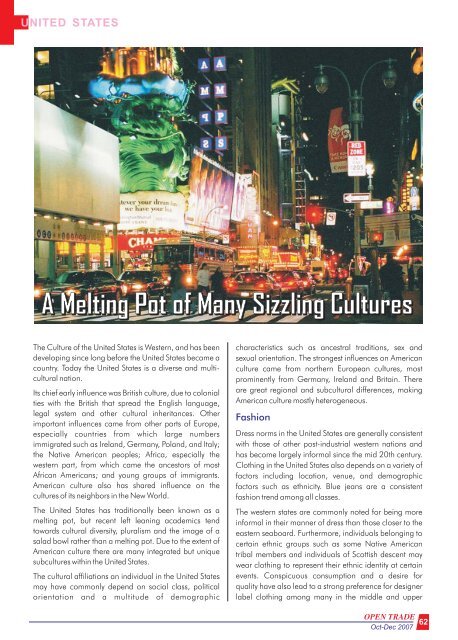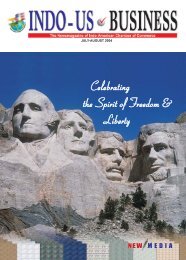pele SciaSction - new media
pele SciaSction - new media
pele SciaSction - new media
You also want an ePaper? Increase the reach of your titles
YUMPU automatically turns print PDFs into web optimized ePapers that Google loves.
UNITED STATES<br />
A Melting Pot of Many Sizzling Cultures<br />
The Culture of the United States is Western, and has been<br />
developing since long before the United States became a<br />
country. Today the United States is a diverse and multicultural<br />
nation.<br />
Its chief early influence was British culture, due to colonial<br />
ties with the British that spread the English language,<br />
legal system and other cultural inheritances. Other<br />
important influences came from other parts of Europe,<br />
especially countries from which large numbers<br />
immigrated such as Ireland, Germany, Poland, and Italy;<br />
the Native American peoples; Africa, especially the<br />
western part, from which came the ancestors of most<br />
African Americans; and young groups of immigrants.<br />
American culture also has shared influence on the<br />
cultures of its neighbors in the New World.<br />
The United States has traditionally been known as a<br />
melting pot, but recent left leaning academics tend<br />
towards cultural diversity, pluralism and the image of a<br />
salad bowl rather than a melting pot. Due to the extent of<br />
American culture there are many integrated but unique<br />
subcultures within the United States.<br />
The cultural affiliations an individual in the United States<br />
may have commonly depend on social class, political<br />
orientation and a multitude of demographic<br />
characteristics such as ancestral traditions, sex and<br />
sexual orientation. The strongest influences on American<br />
culture came from northern European cultures, most<br />
prominently from Germany, Ireland and Britain. There<br />
are great regional and subcultural differences, making<br />
American culture mostly heterogeneous.<br />
Fashion<br />
Dress norms in the United States are generally consistent<br />
with those of other post-industrial western nations and<br />
has become largely informal since the mid 20th century.<br />
Clothing in the United States also depends on a variety of<br />
factors including location, venue, and demographic<br />
factors such as ethnicity. Blue jeans are a consistent<br />
fashion trend among all classes.<br />
The western states are commonly noted for being more<br />
informal in their manner of dress than those closer to the<br />
eastern seaboard. Furthermore, individuals belonging to<br />
certain ethnic groups such as some Native American<br />
tribal members and individuals of Scottish descent may<br />
wear clothing to represent their ethnic identity at certain<br />
events. Conspicuous consumption and a desire for<br />
quality have also lead to a strong preference for designer<br />
label clothing among many in the middle and upper<br />
OPEN TRADE 62<br />
Oct-Dec 2007

















